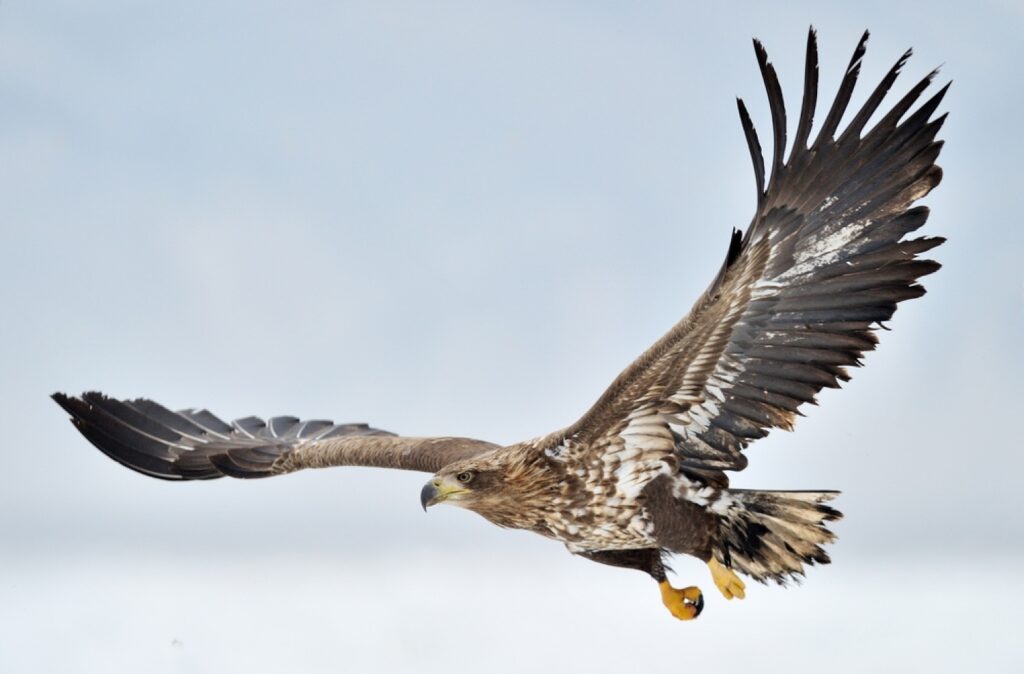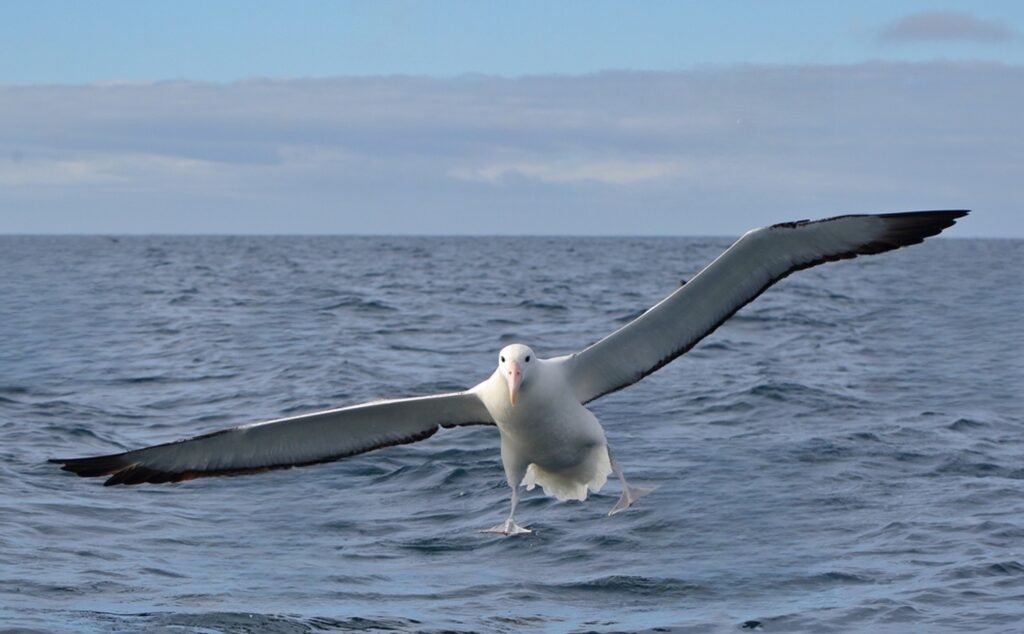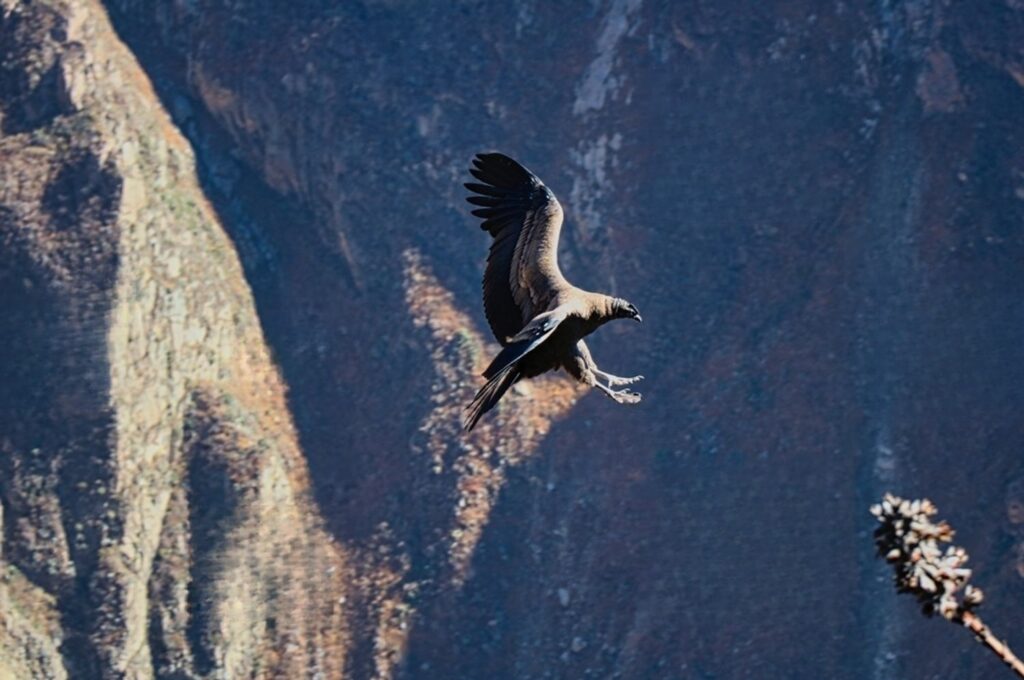What Is The Biggest Flying Bird

The biggest flying bird in the world is the Andean condor (Vultur gryphus), which can have a wingspan of up to 11 feet (3.3 meters). This large bird is native to South America and is found in the Andes mountains and other mountainous regions. The Andean condor is an impressive sight and is often seen soaring in the sky, riding thermal currents and updrafts.
The Andean condor is the national bird of both Colombia and Ecuador and is an endangered species. Its population is threatened by habitat loss, hunting, and poisoning. It has been protected by legislation in some countries since the 1970s, and its population is slowly increasing.
The Andean condor is an impressive bird, with a body length of up to 4 feet (1.2 meters). It has a bald head, with a white collar and white stripe around its neck. Its wings are black, and its body is predominantly black and white. The bird has a long, curved beak and powerful talons, which it uses to feed on carrion.
The Andean condor is a scavenger, and it feeds mainly on carrion, but will also eat small mammals, reptiles, and birds. It is a highly social bird and often forms large flocks when scavenging for food. It is also a powerful flier and can soar for hours without flapping its wings.
The Andean condor is an important symbol in the cultures of South America and is seen as a symbol of freedom and power. It is also a symbol of conservation, and its population is slowly increasing due to increased conservation efforts.
What Is The Biggest Flying Bird

The biggest flying bird in the world is the Andean condor (Vultur gryphus). The Andean condor is the largest species of bird capable of sustained flight. They have a wingspan of up to 3.2 meters (10.5 feet) and a body length of up to 1 meter (3.3 feet). They are found in the Andes Mountains of South America and are an endangered species.
What is a Bird?

A bird is a type of vertebrate animal that is characterized by its ability to fly, along with other physical characteristics such as feathers, a beak, a lightweight skeleton, and hollow bones. There are over 10,000 species of birds, divided into two categories: ratites, which include ostriches, emus, and kiwis, and carinates, which include all other flying birds.
Birds are found around the world in many different habitats, from mountains to deserts. Many species have very specific habitat requirements and can be classified as either aquatic, terrestrial, or aerial.
Birds have a variety of unique physical features that help them to fly and survive in different climates. They have feathers that provide insulation, lift, and streamlining while they fly, and a lightweight skeleton with hollow bones that make them light enough to fly. They also have a beak that is used for preening and feeding.
Birds have a complex social structure and communicate with each other through vocalizations. They are also very vocal, making a variety of calls and songs to communicate with each other.
Birds play an important role in the environment, as they act as pollinators, dispersers of seeds, and predators of insects and other small animals. They also provide food for many other animals, and their presence can be beneficial to the environment.
Characteristics Of A Big Bird
- Large size: Big birds typically have a wingspan greater than two feet, and some species have wingspans of up to nine feet.
- Long, pointed beaks: Big birds have larger and pointed beaks, compared to smaller birds, which are adapted to rip through tough material like wood and bark.
- Strong legs: Big birds have strong legs to support their large size and to facilitate long-distance flight.
- Large wings: Big birds have large wings to provide the lift and power needed for flight.
- High metabolism: Big birds have a higher metabolic rate than smaller birds. This allows them to fly over long distances and to move quickly.
- Bright colors: Big birds often have bright colors, such as yellow, red, and blue, to make them more visible in the sky.
Top Biggest Flying Bird

Wandering Albatross
Andean Condor
Common Ostrich
Dalmatian Pelican
Bald Eagle
Southern Royal Albatross
Wandering Albatross

The Wandering Albatross (Diomedea exulans) is a species of albatross that is found across the Southern Ocean. They are large seabirds with a wingspan of up to 3.3m and weighing up to 11kg. They are one of the most accomplished aerial predators and can stay in the air for days, covering hundreds of kilometers.
Wandering Albatrosses feed primarily on fish, squid, and krill that they catch while soaring through the air. They have a unique way of hunting, by gliding and soaring on the wind currents, they will often circle high above the ocean surface until they spot a potential prey. They will then fold their wings and dive down to catch their prey.
Wandering Albatrosses also spend much of their time in the air. This is because they travel vast distances in search of food, and the air provides them with the most efficient way of doing so. They are able to use the wind currents to their advantage and can cover hundreds of kilometers in a single flight.
The Wandering Albatross is considered a true master of the air, able to glide and soar for hours at a time. They are an iconic species of the Southern Ocean and one of the most awe-inspiring creatures on the planet.
Andean Condor

The Andean condor (Vultur gryphus) is a large bird of prey found in the Andes mountain range of South America. It is the national bird of Argentina, Bolivia, Chile, Colombia, Ecuador, and Peru. The Andean condor is one of two species of New World vultures, the other being the California condor. It is the largest flying land bird in the Western Hemisphere, with a wingspan of up to 3 m (10 ft).
The Andean condor spends most of its time soaring through the air in search of food. It feeds primarily on carrion, but also on small mammals, reptiles, and birds. They typically breed in high, rocky terrain, and their nests are usually found on cliffs and rocky outcrops. The female lays one to two eggs, and both parents take part in incubating them.
The Andean condor is renowned for its ability to fly for extended periods of time without flapping its wings. It uses thermal air currents to gain altitude and then glides for long distances. This allows it to cover large areas in search of food. The species is listed as “Near Threatened” by the IUCN, due to habitat loss and decline in its population.
Common Ostrich

Common Ostriches are the largest and most widespread of the world’s nine species of ostriches. They inhabit savannas, grasslands, and deserts in Africa, and have become well-adapted to their environment. Common Ostriches have a wingspan of approximately 2 meters and can reach speeds of up to 70 km/h. They are able to stay in the air for long periods of time and are able to use thermals and air currents to gain altitude and travel long distances. The ostrich’s flight capabilities enable it to outrun predators, and its wings provide protection from the sun’s rays. Additionally, common ostriches are able to use their wings to defend themselves by flapping them vigorously. As a result, the common ostrich is considered one of the most efficient flyers in the world.
Dalmatian Pelican

The Dalmatian pelican is the largest of all pelican species, with a wingspan of up to 3.5 meters and a body weight of up to 13 kg. These large birds are migratory and can be found throughout Europe, Asia, and Africa. They prefer to live in shallow lakes and wetlands, where they feed on fish and other aquatic creatures. They are also known to use their large bills to scoop up water and spray it over their prey. During the breeding season, these birds gather in large flocks to perform spectacular courtship displays.
In the air, Dalmatian pelicans are graceful flyers, capable of soaring and gliding for long distances. They typically fly in large flocks, which can be seen from miles away. These birds use their powerful wings to fly at speeds of up to 80 km/h. During the winter months, they migrate south to warmer climates, where they can find a plentiful supply of food. When in flight, they often seek out thermals, which they use to gain altitude and conserve energy.
Bald Eagle

The bald eagle (Haliaeetus leucocephalus) is a large bird of prey native to North America and is the national bird of the United States. This majestic bird is easily identified by its white head and tail feathers, which contrast sharply with its dark brown body. The bald eagle is renowned for its strength, endurance, and majestic beauty.
The bald eagle is a magnificent flyer and can reach speeds of up to 100 mph in level flight. Bald eagles have a wingspan of up to 8 feet, and they are capable of soaring for hours at a time. During the breeding season, bald eagles can be seen performing aerial courtship displays high up in the sky. The male and female will circle each other in the air, locking talons and then releasing, and sometimes even flying upside down in their displays of affection.
The bald eagle is an opportunistic feeder and will eat anything from fish and small mammals to carrion. Bald eagles can be seen perched in trees along the shoreline, watching for prey in the water below. Bald eagles are also known to steal food from other birds, such as ospreys, which are also found in the same areas.
Bald eagles typically mate for life, and both parents work together to build the nest and care for the young. The nest is usually built high in a tall tree and can be up to 10 feet across and weigh up to 1,000 pounds.
The bald eagle is an iconic symbol of the United States, and its population has rebounded in recent years due to conservation efforts. It is a beautiful and impressive creature, and its presence in the sky is a sight to behold.
Southern Royal Albatross

The Southern Royal Albatross is a large sea bird found in the Southern Ocean. It is the largest of the albatross species, with a wingspan of up to 3.7 m (12 ft). It is an endangered species, with only an estimated 15,000 individuals remaining.
The Southern Royal Albatross spends most of its life in the air. It spends its days soaring over the ocean, looking for food. As it glides, it rides thermals and wind currents, conserving energy and allowing it to travel large distances without expending too much energy. It also uses dynamic soaring, where it repeatedly dives and rises up again, to gain momentum and increase its speed.
When it needs to rest, the Southern Royal Albatross will settle on the ocean surface. It does not need to often rest, as it can remain in the air for days or even weeks at a time.
The Southern Royal Albatross feeds on fish, squid, and krill. It uses its long bill to scoop up prey from the ocean surface. It often feeds in flocks, and will sometimes follow ships in order to feed on the fish disturbed by their wake.
The Southern Royal Albatross breeds in colonies on remote islands in the Southern Ocean. Each pair will lay a single egg each year, and the chicks will remain in the nest for up to 12 months before fledging.
The Southern Royal Albatross faces many threats, including longline fishing, plastic pollution, and climate change. Its population is slowly declining, and it is listed as endangered on the IUCN Red List.
Pros and Cons of Biggest Flying Bird To The Ecosystem

Pros:
- The biggest flying birds help to disperse seeds and pollen, providing pollination and helping to propagate plants in the ecosystem.
- They are also important predators, controlling populations of insects and small rodents, which in turn helps to maintain the balance of the ecosystem.
- Biggest flying birds are also important environmental indicators, as their numbers can be used to measure the health of the ecosystem.
- They are also a source of great beauty and fascination, providing aesthetic value to the environment.
Cons:
- Biggest flying birds may compete with other smaller birds for food and nesting sites, leading to reduced numbers of some species.
- They may also be seen as a threat to aircraft and may need to be controlled in certain areas.
- Their large size and loud calls may disturb some people, leading to complaints from those living near their habitats.
FAQ
Q. What is the biggest flying bird alive today
A. The largest living flying bird is the Wandering Albatross (Diomedea exulans). It is found in the Southern Ocean and is known for its long-distance flights, covering thousands of miles in a single journey.
Q. What is the biggest flying bird in the US
A. The biggest flying bird in the US is the California Condor.
Q. What is the biggest flying bird on earth
A. The biggest flying bird on earth is the Wandering. It is found in the Southern Ocean and is the largest seabird in the world.
Q. How big is the biggest flying bird
A. The world’s largest flying bird is the Wandering Albatross (Diomedea exulans), which has a wingspan of up to 3.3 meters (11 feet).
Conclusion
The biggest flying bird is the wandering albatross, which can have a wingspan of up to 3.3 meters (11 feet). This bird is a powerful glider, able to soar for hours on end without flapping its wings. It is found mainly in the Southern Ocean and feeds mainly on fish, squid, and krill. The wandering albatross is listed as vulnerable by the IUCN due to its small population size and slow reproductive rate.

